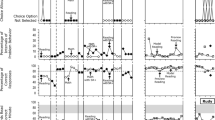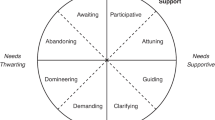Abstract
A multiple-probe across-subjects design was used to examine persuasive writing performance of six 2nd- through 5th- grade students with emotional/behavior disorders (EBD). Students’ writing was evaluated before and after self-regulated strategy development (SRSD) instruction for the POW (Pick my idea, Organize my notes, Write and say more) + TREE (Topic sentence, Reasons – three or more, Ending, Examine) strategy. Students’ essays written during and immediately after instruction indicated that the students had learned to write independently a persuasive essay with five parts. Generalization and maintenance performance, however, varied across students and appeared to be associated with behavior as opposed to the inability to transfer or remember the strategy.


Similar content being viewed by others
References
Alberto, P. A., & Troutman, A. C. (2005). Applied behavior analysis for teachers (6th ed). Upper Saddle River, NJ: Merrill.
Baker, S., Gertsen, R., & Scanlon, D. (2002). Procedural facilitators and cognitive strategies: Tools for unraveling the mysteries of comprehension and the writing process, and for providing meaningful access to the general curriculum. Learning Disabilities Research and Practice, 17, 65–77.
Bereiter, C., & Scardamalia, M. (1982). From conversation to composition: The role of instruction a developmental process. In R. Glaser (Ed.), Advances in instructional psychology (Vol. 2, pp. 1–64). Hillsdale, NJ: Erlbaum.
Binder, C. (1996). Behavioral fluency: Evolution of a new paradigm. The Behavior Analyst, 19, 163–197.
Bos, C. S. (1989). The effects of an interactive instructional strategy for enhancing reading comprehension and content area learning for students with learning disabilities. Journal of Learning Disabilities, 22, 384–390.
Graham, S. (2006). Strategy instruction and the teaching of writing. In C. MacArthur, S. Graham, & J. Fitzgerald (Eds.), Handbook of Writing Research (pp. 187–207). New York: Guilford.
Graham, S., & Harris, K. R. (2003). Students with learning disabilities and the process of writing: A meta-analysis of SRSD studies. In H. L. Swanson, K. R. Harris, & S. Graham (Eds.), Handbook of learning disabilities (pp 323–344). New York: Guilford Press.
Graham, S., Harris, K. R., & Mason, L. H. (2005). Improving the writing performance, knowledge, and self-efficacy of struggling young writers: The effects of self-regulated strategy development. Contemporary Educational Psychology, 30, 207–241.
Harris, K. R., & Graham, S. (1999). Programmatic intervention research: Illustrations from the evolution of self-regulated strategy development. Learning Disabilities Quarterly, 22, 251–262.
Harris, K. R., Graham, S., & Mason, L. H. (2006). Improving the writing performance, knowledge, and motivation of struggling writers in second grade: The effects of self-regulated strategy development. American Educational Research Journal, 42, 295–340.
Harris, K. R., Graham, S., & Mason, L. H. (2003). Self-regulated strategy development in the classroom: Part of a balanced approach to writing instruction for students with disabilities. Focus on Exceptional Children, 35, 1–16.
Hersen, M., & Barlow, D. H. (1978). Single-case experimental designs: Strategies for studying behavior change. New York: Pergamon Press.
Horner, R. D., & Baer, D. M. (1978). Multiple-probe technique: A variation of the multiple probe baseline. Journal of Applied Behavior Analysis, 11, 189–196.
Ivarie, J. J. (1986). Effects of proficiency rates on later performance of a recall and writing behavior. Remedial and Special Education, 7, 25–30.
Kazdin, A. E. (1982). Single-case research designs: Methods for clinical and applied settings. New York: Oxford University Press.
Lane, K. L. (2004). Academic instruction and tutoring interventions for students with emotional/behavioral disorders: 1990 to present . In R. B. Rutherford, M. M. Quinn, & S. R. Mathur (Eds.). Handbook of research in emotional and behavioral disorders (pp. 462–486). New York: Guilford Press.
Langer, J., & Applebee, A. N. (1987). How writing shapes thinking. Urbana, IL: National Council of Teachers of English.
Mason, L. H. (2006). [Explicit instruction for strategy development in two multi-component expository reading interventions: Effects for students who struggle with comprehension.] Unpublished raw data.
Mason, L. H., Harris, K. R., & Graham, S. (2002). Every child has a story to tell: Self-regulated strategy development for story writing. Education and Treatment of Children, 25, 496–506.
Mason, L. H., Hickey Snyder, K., Jones, D. P., & Kedem, Y. (2006). TWA + PLANS strategies for expository reading and writing: Effects for nine 4th-grade students. Exceptional Children, 73, 69–89.
Mason, L. H., & Meadan, H. (2006). [Longitudinal effects of self-regulated reading comprehension and writing strategy instruction for 4th grade students who struggle with learning: A components analysis.] Unpublished raw data.
Mercer, C. D., & Mercer, A. R. (2005) Teaching students with learning problems (7th ed). Upper Saddle River, NJ: Merrill.
Montague, M., Enders, C., & Castro, M. (2005). Academic and behavioral outcomes for students at risk for emotional and behavioral disorders. Behavioral Disorders, 31, 84–94.
Mooney, P., Epstein, M. H., Reid, R., & Nelson, J. R. (2003). Status and trends of academic research for students with emotional disturbance. Remedial and Special Education, 24, 273–287.
Nelson, J. R., Benner, G. J., Lane, K. L., & Smith, B. W. (2004). Academic achievement of K-12 students with emotional and behavioral disorders. Exceptional Children, 71, 59–73.
Penno, D. A., Frank, A. R., & Wacker, D. P. (2000). Instructional accommodations for adolescent students with severe emotional for behavioral disorders. Behavioral Disorders, 25, 325–343.
Regan, K. S., Mastropieri, M. A., & Scruggs, T. E. (2005). Promoting expressive writing among students with emotional and behavioral disturbance via dialogue journals. Behavioral Disorders, 31, 33–50.
Ruhl, K. L., & Berlinghoff, D. H. (1992). Research on improving behaviorally disordered students’ academic performance: A review of the literature. Behavioral Disorders, 23, 5–17.
Sutherland, K. S., & Wehby, J. H. (2001). The effect of self-evaluation on teaching behavior in classrooms for students with emotional and behavioral disorders. The Journal of Special Education, 35, 161–171.
Sutherland, K. S., & Wehby, J. H., & Yoder, P. J. (2002). Examination of the relationship between teacher praise and opportunities to respond for students with EBD to respond to academic requests. Journal of Emotional and Behavioral Disorders, 10, 5–13.
Swanson, H. L. (1989). Central processing strategy difference in gifted, normal achieving, learning disabled, and mentally retarded children. Journal of Experimental Child Psychology, 47, 378–397.
Tawney, J. W., & Gast, D. L. (1984). Single subject research in special education. New York: Merrill.
Trout, A. L., Nordness, P. D., Pierce, C. D., & Epstein, M. H. (2003). Research on the academic status of children with emotional and behavioral disorders: A review of the literature from 1961 to 2000. Journal of Emotional and Behavioral Disorders, 11, 198–210.
Wong, B. Y. L. (1986). Instructional strategies for enhancing learning disabled students’ reading comprehension and comprehension test performance. Canadian Journal for Exceptional Children, 2, 128–132.
Ysseldyke, S., Nelson, J., Christenson, S., Johnson, D. R., Dennison, A., Triezenberg, H., Sharpe, M., & Hawres, M. (2004). What we know and need to know about the consequences of high-stakes testing of students with disabilities. Exceptional Children, 71, 75–94.
Acknowledgements
Preparation of this article was funded by Campus Research Board Grant, University of Illinois, Urbana-Champaign. The authors would like to thank Rahul Ganguly, Yore Kedem, Diana Sukrham, and Ray Taft for their support in this project.
Author information
Authors and Affiliations
Corresponding author
Appendix A
Appendix A
Holistic Quality Score
Score of 10. Persuasive essay includes topic sentence, more than three reasons with at least three explanations, and an ending sentence. Essay is written in a logical sequence that strengthens the writer’s argument. Writer uses more than one counter argument/point in the essay.
Score of 9. Persuasive essay includes topic sentence, more than three reasons, at least 3 explanations, and an ending sentence. Essay is written in a logical sequence that strengthens the writer’s argument. Writer uses 1 counter argument/point in the essay.
Score of 8. Persuasive essay includes topic sentence, more than three reasons, at least 2 explanations, and an ending sentence. Essay is written in a logical sequence that strengthens the writer’s argument.
Score of 7. Persuasive essay includes topic sentence, three reasons with at least two explanations, and ending sentence. Essay is written in a logical sequence that strengthens the writer’s argument.
Score of 6. Persuasive essay includes topic sentence, three reasons with at least 1 explanation, and ending sentence. Essay’s sequence is weak, therefore limiting the writer’s argument.
Score of 5. Persuasive essay includes topic sentence, three reasons, and ending sentence.
Score of 4. Persuasive essay includes four of the following parts: topic sentence, reasons, and ending sentence.
Score of 3. Persuasive essay includes three of the following parts: topic sentence, three reasons, and ending sentence.
Score of 2. Persuasive essay includes two of the following parts: topic sentence, reasons, and ending sentence.
Score of 1. Persuasive essay includes one of the following parts: topic sentence, reason, and ending sentence.
Score of 0. No essay parts.
Rights and permissions
About this article
Cite this article
Mason, L.H., Shriner, J.G. Self-regulated strategy development instruction for writing an opinion essay: Effects for six students with emotional/behavior disorders. Read Writ 21, 71–93 (2008). https://doi.org/10.1007/s11145-007-9065-y
Published:
Issue Date:
DOI: https://doi.org/10.1007/s11145-007-9065-y




